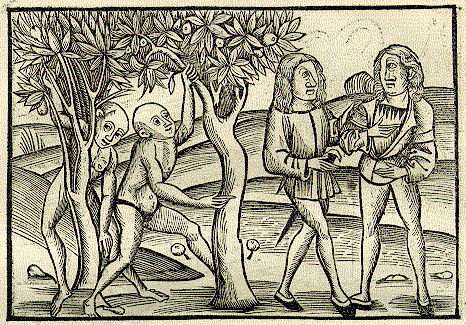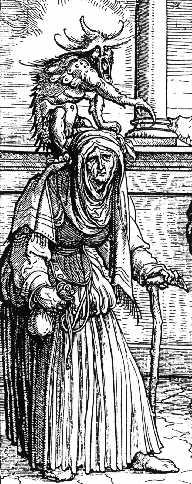Mythologischer Hintergrund
Guide
to Mythological References in Goethe's Faust
Carolyn Miller
This is a partial listing, in the order that they first appear
in the original text, of the main mythological figures that you
will encounter. When multiple references appear in one scene,
they are listed alphabetically.
http://www.ucalgary.ca/~esleben/faust/goethe/mythology.html
Samothrake
und die Kabiren
Links zu den Mysterienstätten von Samothrake und den Kabiren.
http://www.anthroposophie.net/bibliothek/geschichte/antike/bib_antike_kabiren.htm
Rudolf
Steiner: Über die Kabiren
Rudolf Steiner
Auszüge aus verschiedenen Vorträgen Rudolf Steiners über die
Kabiren und die Mysterien von Samothrake.
http://www.anthroposophie.net/steiner/bib_steiner_kabiren.htm
Sebastian Brants "Esop"
Das reich illustrierte Fabelbuch von
1501, das hier erstmals wieder zugänglich
gemacht wird, fand beim zeitgenössischen
Publikum großen Anklang. In deutscher
Übersetzung wurde es im 16. Jahrhundert noch
siebenmal aufgelegt. Die Forschung hingegen hat
sich mit Sebastian Brants "Esopus"
nicht näher befaßt. Ihr schien das Buch nur
eine der zahlreichen Neuausgaben bekannter Werke
zu sein, die Brant als Berater mehrerer Basler
Drucker betreut hat. Daß der berühmte Autor gut
ein Achtel des Textes selbst verfaßt und drei
Achtel des Werks aus den verschiedensten Quellen
kompiliert hat, wurde ebensowenig gewürdigt wie
die hervorragende Qualität der Holzschnitte, die
ein anonymer Künstler für den 2. Teil dieser
Ausgabe neu geschaffen hat.
Hier finden sich wertvolle Angaben zu den
fabelhaften mythischen Figuren aus FAUST II.
S. 387 Von
den Arimaspen und Arymphäern:

Herodot
erzählt, daß im asiatischen Skythien nach
Norden hin die Arimaspen leben, die auf der Mitte
der Stirn ein einziges Auge haben. Sie liegen mit
den wilden Greifvögeln in dauerndem Kampf; denn
diese graben Gold und Edelsteine aus
unterirdischen Stollen, die Arimaspen aber nehmen
es ihnen mit Gewalt weg und stecken sich - gleich
ob Männer oder Frauen - das Gold ins Haar.
S. 389 Der
Krieg der Pygmäen und der Kraniche:

Die
Pygmäen leben in Indien in einem Gebirge unweit
des Meeres. Die größten unter ihnen messen
nicht mehr als zweieinviertel Fuß. Sie liegen
mit den Kranichen im Krieg, wie schon Homer sagt.
Ihre Krieger stürmen in Waffen gegen diese
Vögel an, unterliegen ihnen aber endlich und
werden von ihnen durch die Luft entführt. Im
Frühjahr sollen die Pygmäen, auf Ziegen reitend
und mit Pfeilen gerüstet, zum Strand ziehen und
die Eier und Küken der Kraniche vernichten, weil
sie gegen die ausgewachsenen Vögel nicht mehr
ankommen.
http://www.uni-mannheim.de/mateo/desbillons/esop.html
Die Kraniche des Ibykus
Friedrich Schiller
http://www.gutenberg2000.de/schiller/gedichte/ibykus.htm
Die
Graien, Skylla, Charybdis und die Gorgonen
G. Bosold
Die Meeresgottheiten Phorbys und Keto,
wie Nereus
Nachkommen von Gaia
und Pontos,
zeugten die Graien, die Meeresungeheuer Skylla und Charybdis wie
auch die schrecklichen Gorgonen.
http://www.bosold.de/sagen/dcd.htm
Encyclopedia Mythica - Article: Graeae
Über die Phorkyaden
oder Graien, die drei "grauen Weiber"
der griechischen Mythologie, die Perseus
gezwungen hat, ihm den Weg zu den Gorgonen zu
weisen:
The three "old women" or "gray
ones" from Greek mythology. They are the
daughters of Phorcys and Ceto, sisters
and guardians of the Gorgons. They were
gray-haired from birth and have only one eye and
one tooth, which they share among them. They are Enyo ("horror"),
Deino ("dread") and Pemphredo
("alarm").
http://www.pantheon.org/articles/g/graeae.html
Bulfinch's Mythology: THE GRAEAE AND THE
GORGONS, PERSEUS AND MEDUSA, ATLAS, ANDROMEDA.
The Graeae were three
sisters who were gray-haired from their birth,
whence their name. The Gorgons were
monstrous females with huge teeth like those of
swine, brazen claws, and snaky hair. None of
these beings make much figure in mythology except
Medusa, the
Gorgon, whose story we shall next advert to. We
mention them chiefly to introduce an ingenious
theory of some modern writers, namely, that the
Gorgons and Graeae were only personifications of
the terrors of the sea, the former denoting the
strong billows of the wide open main, and the
latter the white-crested waves that dash against
the rocks of the coast. Their names in Greek
signify the above epithets.
http://www.bulfinch.org/fables/bull15.html
Nereus,
the Old Man of the Sea
Jeremiah Genest - jgenest@neaccess.net
Hesiod describes the negative powers of the children of Night,
and then lists the descendants of Pontus, beginning with the
eldest and most venerable, Nereus, the Sea's Ancient or the Old
Man of the Sea: "But Pontos, the great Sea, was Father of
truthful (apseudes) Nereus, who tells no lies (alethes),
eldest of his sons. They call him the old Gentleman because he
is trustworthy (nemertes), and gentle, and never
forgetful of what is right (oude themisteon lethetai),
but the thoughts of his mind are mild and righteous (dikaia
kai epia)" (Theogony 233-36). Three epithets,
alethes, apseudes and nemertes,
confer exceptional importance on Nereus. The association of
these three epithets is in all likelihood traditional, since we
also find them linked in this way in the description of the
highest form of mantic speech, that of Apollo. In the Homeric
Hymn to Hermes, when Hermes speaks before the gods, he
claims in an ad hominem argument addressed to Apollo
that he has the same virtues as those usually associated with
his rival (368-69). He declares that he will speak Aletheia
and that he is nemertes and apseudes. The
"truth" of the Old an of the Sea thus seems to cover
two domains: prophecy and justice. To understand the nature of
this truth, we must first decipher the relations between Aletheia
and both mantic speech and justice and then specify the
modalities of the justice dispensed by the Old Man of the Sea.
To discover Nereus's "truth" it is necessary to
investigate the institutions intimately connected to the Old Man
of the Sea.
http://www.neaccess.net/~jbgenest/secretum/myths/nereus.html
Hekate
Die dreifaltig gestaltete Mondgöttin Heakte, Meisterin der
Hexen und Herrin aller Magie.
http://www.anthroposophie.net/bibliothek/religion/mythologie/bib_hekate.htm
 C. M. Wieland: Musarion oder die
Philosophie der Grazien C. M. Wieland: Musarion oder die
Philosophie der Grazien
Ein Gedicht in drei Büchern. Nach
der Ausgabe letzter Hand (1794 - 1802).
http://www.gutenberg2000.de/wieland/musarion/musarion.htm
Erichtho
...The Roman historian Lucan told an
even more harrowing tale of a summoning during
the Civil Wars. Sextus Pompey, anticipating
battle on the morrow with Caesar's host, asked
the archwitch Erichtho for advice. She was a
fearful woman, who "never hesitated to
commit murder, should the warm life blood from a
slit throat be needed for her spells." But
she agreed to help, provided a "clear-voiced
recent corpse" could be found among the crop
of dead from that day's skirmish. The witch
selected a relatively undamaged cadaver, drained
it veins and replenished them with warm menstrual
blood mixed with the froth of dogs suffering from
hydrophobia, a lynx's guts, the hump of a
corpse-eating hyena and other extraordinary
ingredients. And when Sextus and his retinue
flinched in terror, she sneered, "Cowards it
is the dead who have reason to fear me
!" The wretched victim was duly made to
speak. But for his pains, Sextus got little joy
from the prophecy. "Tell your family not to
shrink from the death," said the dead man
grimly, and the next say Sextus' army was
destroyed at Pharsalus.
http://www.cygnus.uwa.edu.au/~corwin/ArsMagica/References/Legends/Erichtho.html
Lamien
In der griechischen Mythologie sind
die Lamien vampierartige Wesen, die kleine Kinder
rauben und ihr Blut trinken. Sie werden meist als
schlangenhafte Wesen mit weiblichem Kopf und
Brüsten dargestellt.
http://www.anthroposophie.net/bibliothek/religion/mythologie/bib_lamia.htm
Lilith
Nach jüdischer Tradition hatte Adam
vor Eva noch eine andere Frau - Lilith. Sie soll
die Mutter vieler Dämonen, ja sogar die Mutter
Luzifers selbst sein. Goethe läßt sie in seiner
"romantischen Walpurgisnacht"
erscheinen.
http://www.anthroposophie.net/bibliothek/religion/mythologie/bib_lilith.htm
|



